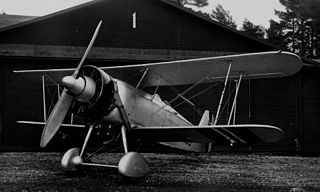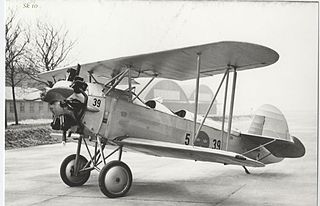
The Fokker D.XXI fighter was designed in 1935 by Dutch aircraft manufacturer Fokker in response to requirements laid out by the Royal Netherlands East Indies Army Air Force.

Svenska Aero Jaktfalken ("Gyrfalcon") was a Swedish biplane fighter aircraft, constructed in the late 1920s. The aircraft was first manufactured by Svenska Aero and later by AB Svenska Järnvägsverkstädernas Aeroplanavdelning (ASJA).

The Valmet Tuuli was a trainer aircraft, developed for the Finnish Air Force by the State Aircraft Factory. The aircraft was to be produced in 3 different versions. The last version, Tuuli III was redesigned from scratch, and is basically an entirely different aircraft.

Adaridi AD 3 was a wooden aircraft designed by the Russian engineer Boris Adaridin, who lived in Finland. It was a high wing aircraft with a low-powered engine. In 1923, the Finnish Air Force ordered one Adaridi aircraft. The aircraft was not given any official designation code. The maiden flight was on April 17, 1924.

Friedrichshafen FF.33 was a German single-engined reconnaissance three-bay wing structure biplane, using twin floats, designed by Flugzeugbau Friedrichshafen in 1914 for the Marine-Fliegerabteilung aviation forces of the Kaiserliche Marine.
The Friedrichshafen FF.41a was a large, German-built, three-seat, twin-engine floatplane reconnaissance aircraft designed by Flugzeugbau Friedrichshafen in 1917.

Friedrichshafen FF.49 was a German, two-seat, single-engine float-plane designed by Flugzeugbau Friedrichshafen in 1917.

Georges Levy G.L. 40 HB2 was a three-seated French, amphibious biplane aircraft that was designed in 1917. The aircraft was designed by Blanchard and Le Pen and therefore the aircraft was also known as the Levy-Le Pen. Le Pen was Maurice Jules-Marie Le Pen born in Lorient, Morbihan, France in 1889; he was killed in a car crash in 1919. It was claimed to be the best French amphibious aircraft of World War I, but that is probably due to the low scale production of such aircraft in France at that time.

IVL C.VI.25 was a Finnish fighter aircraft designed by IVL. It was a further development of the IVL C.24.

IVL K.1 Kurki was a prototype for a four-seated, high-wing trainer aircraft, which was designed in 1927 by IVL. The designer was Asser Järvinen and the prototype was manufactured at the IVL plant at Suomenlinna. The aircraft made its maiden flight on March 30, 1927. Only one aircraft was manufactured.

Junkers A 35 was a two-seater cantilever monoplane, used for postal, training and military purposes. The aircraft was designed in the 1920s by Junkers in Germany and manufactured at Dessau and by AB Flygindustri in Limhamn, Sweden and conversions from A 20s were made in Fili, Russia.

The LVG C.VI was a German two-seat reconnaissance and artillery spotting aircraft used during World War I.

Grigorovich M-9 was a Russian World War I-era biplane flying boat, developed from the M-5 by Grigorovich.

Grigorovich M-15 was a successful Russian World War I-era biplane flying boat, developed from the M-9 by Grigorovich.
Grigorovich M-16 was a successful Russian World War I-era biplane flying boat of the Farman type, developed from the M-9 by Grigorovich. Somewhat larger than the M-9, the M-16 was a version especially intended for winter operations, with better aerodynamic qualities.

Morane-Saulnier MoS-50 was a French parasol configuration trainer aircraft built in 1924. The twin-seat aircraft was of wooden construction and was one of the last aircraft to have a rotary engine, a 97 kW (130 hp) Clerget 9B.

Raab-Katzenstein RK-26 Tigerschwalbe, also known as the Fieseler F 1 Tigerschwalbe, was a German twin-seat biplane trainer aircraft designed by Gerhard Fieseler by the end of the 1920s.
Kurt Volmar Berger (1896–1977) was an aviation engineer and the chief designer at the Finnish aircraft manufacturing company Valtion Lentokonetehtaat.

Hansa-Brandenburg W.33 was a German two-seat, single-engined low-wing monoplane floatplane, which had been developed by Hansa und Brandenburgische Flugzeugwerke during World War I as a higher powered enlargement of the similar Hansa-Brandenburg W.29 and despite the increase in size the two types are very difficult to differentiate. Although the W.33 was built in small numbers during the war many license built versions were built after World War I.
The Friedrichshafen FF.71 was a German biplane floatplane of the 1910s produced by Flugzeugbau Friedrichshafen.

















